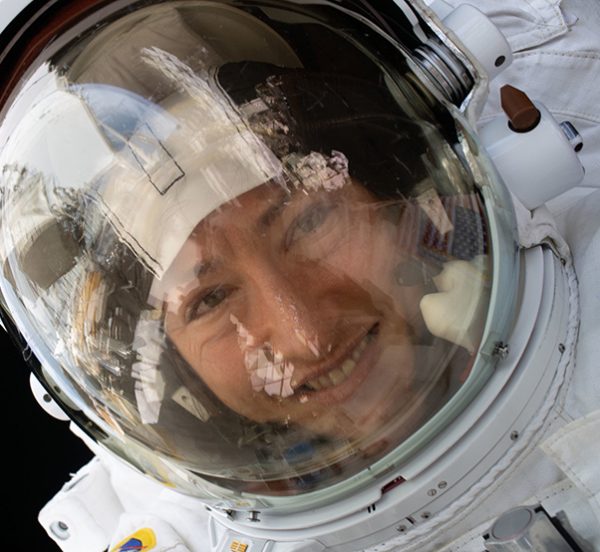Astronaut has served longest space flight by a woman – Aerotech News
NASA astronaut Christina Koch returned to Earth from the International Space Station on Feb. 6, 2020. She returned alongside European Space Agency astronaut Luca Parmitano and Russian cosmonaut Alexander Skvortsov.
Her mission was the longest single spaceflight by any woman, which is helping scientists gather data for future missions to the Moon and Mars.
For American astronauts, only former astronaut Scott Kelly completed a longer spaceflight of 340 days in 2015 and 2016.
During her time in space, Koch shattered records as part of three expeditions and the first all-woman spacewalk (and the second, and the third), and facilitated a myriad of research studies.
She was a crew member for three expeditions — 59, 60 and 61 — during what was her first spaceflight.
Before returning to Earth, Koch shared some of her most memorable moments living and working on the station. But she recalls special moments in between, made memorable because of the people who helped make them possible and her unique perspective “floating” in orbit 250 miles above her home planet.
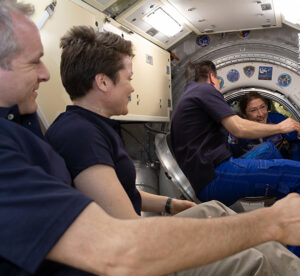
Arriving at space station
On March 14, 2019, Koch reached the space station after a six-hour journey on the Soyuz spacecraft alongside NASA astronaut Nick Hague and Roscosmos cosmonaut Aleksey Ovchinin to commence Expedition 59. As the first person through the hatch upon arrival, she remembers seeing both colleagues and friends and experiencing the “actual” interior of the space station for the first time. “That was the day that I have seared in my memory,” she says. “Visions from when I first arrived here … I’m very privileged to have that as one of my favorite memories.”
Not missing a beat during karaoke
Asked what made her laugh the hardest while on the space station, Koch explains it happened during karaoke while singing to a crew favorite, “Wind of Change.” During the song, the internet connection dropped (during a normal antenna adjustment) ending the music video for about 10 minutes. The crew continued a casual conversation while waiting, but the moment the internet reconnected, and the music continued, the crew started singing right where they left off as if they hadn’t been interrupted. “That was a really, really great moment,” Koch said.
Pizza nights
Although Koch enjoyed the meals that the crew can share together as a team, she says she particularly enjoyed pizza nights — compliments of the care packages sent from those on the ground that included non-perishable pizza kits. “We’re able to make pizzas in our kind of makeshift space oven using tin foil and a little bit of creativity,” she says confessing that it is a welcome change to the normal dinnertime routine.
First glimpse of home from way up above
Koch, who grew up in Jacksonville, N.C., recalls taking in the views of the state she calls home.
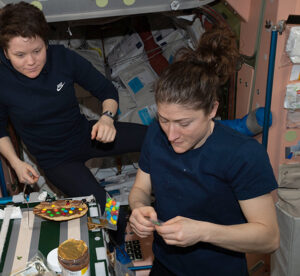
“One really striking moment was the first time I saw my hometown in the area where I grew up, which is coastal North Carolina.” Other favorite views of Earth from the station include the auroras, both the northern and southern lights, because she spent many years working in both the Antarctic and Arctic where she viewed the auroras from the ground below.
Walking out into space
Recounting her first spacewalk on March 29, 2019, during Expedition 59, Koch describes seeing Earth gliding by behind her spacewalking partner, Nick Hague, and recognizing that Earth was clearer than she had ever seen it in any window on the space station.
“At that moment, I just felt like everything I had ever worked for, everything I had ever loved, everything I had ever wanted to contribute to my entire life was just culminating in that moment.” Koch also shared how unique her series of spacewalks were with NASA astronaut Drew Morgan and how much of an honor it was to walk out into space with NASA astronaut Jessica Meir as part of the first all-woman spacewalk in history on Oct. 18, 2019.
“We caught each other’s eye and we knew that we were really honored with this opportunity to inspire so many, and just hearing our voices talk to Mission Control, knowing two female voices had never been on the loops, solving those problems together outside — it was a really special feeling.”
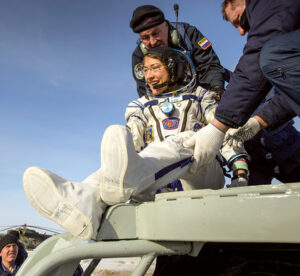
Human body, mind’s ability to adapt to any situation
Koch, after spending some time on the space station, says she may have “actually forgotten that [she] was floating.” She describes how surprising it was to realize the capacity of the human mind to normalize the act of floating, and how working upside down is just as natural as working right-side up. “It’s been a huge surprise to see that life up here can actually become normal because of what our bodies can adapt to.”
Receiving handwritten letters from her husband
Cargo resupply missions often bring the astronauts special treats. Koch talked about the most memorable items she received, handwritten letters from her husband. She pointed out that even though there is a delay between when the letter was written and when it arrived on the space station, “the letters are not necessarily relevant to the moment, but the fact that they can express things and that it’s something that someone you love on Earth actually was holding in their hands is really special.”
Koch’s work during her record-setting mission included participation in more than 210 investigations, helping advance NASA’s goals to return humans to the Moon under the Artemis program and prepare for human exploration of Mars. Koch participated in a number of studies to support those future exploration missions, including research into how the human body adjusts to weightlessness, isolation, radiation and the stress of long-duration spaceflight.
One particular research project Koch participated in is the Vertebral Strength investigation, which better defines the extent of spaceflight-induced bone and muscle degradation of the spine, and the associated risk for broken vertebrae. This timely endeavor is expected to provide insight into the development of future countermeasures, such as preventative medicine or exercise. These results also could provide recommendations for limiting the amount of force astronauts are subjected to during launch.
Koch’s most memorable experiments during her time on the space station included work on the Microgravity Crystals investigation, which crystallizes a membrane protein that is integral to tumor growth and cancer survival. Although crystallization of this protein has yielded unsatisfactory results on Earth, this investigation leverages extensive protein crystallization work on the space station, significantly increasing the likelihood of successful crystal growth. Results may support the development of cancer treatments that target the protein more effectively and with fewer side effects.
NASA has gathered vast amounts of data about astronaut health and performance during the past 60 years and has focused recently on extended durations up to one year with the dedicated mission of Scott Kelly, Peggy Whitson’s three long-duration space missions that together lasted 665 days, and now the extended-duration missions of both Koch and NASA astronaut Andrew Morgan, who is in the midst of a 10-month mission. These opportunities also have demonstrated there is a significant degree of variability in human response to spaceflight, as well as the importance of determining the acceptable degree of change for both men and women.
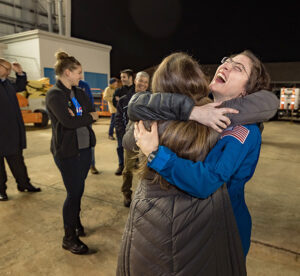
NASA has a rigorous training process to prepare astronauts for their missions, a thoroughly planned lifestyle and work regimen while in space, and an excellent rehabilitation and reconditioning program for them after they return to Earth. Thanks to these measures, the human body remains robust and resilient even after spending nearly a year in space. Research from these studies will guide NASA’s research for years to come, as NASA continues to prioritize the health and safety of astronauts on spaceflight missions, particularly long-duration missions aboard the International Space Station, as well as missions to the Moon, Mars, and beyond.
During her spaceflight, Koch completed 5,248 orbits of Earth and a journey of 139 million miles, roughly the equivalent of 291 trips to the Moon and back. She also supported the arrivals and/or departures of more than a dozen Soyuz and cargo resupply spacecraft from the U.S., Japan and Russia.
About Christina Koch
Christina Koch is a native of Michigan, grew up in Jacksonville, N.C., and now lives in Livingston, Mont. She graduated from North Carolina State University with a B.S. in Electrical Engineering and Physics and an M.S. in Electrical Engineering. Koch was selected as an astronaut by NASA in 2013.
Koch’s career prior to becoming an astronaut spanned two general areas: space science instrument development and remote scientific field engineering. Her career began as an Electrical Engineer at NASA Goddard Space Flight Center’s Laboratory for High Energy Astrophysics, where she contributed to scientific instruments on several NASA missions studying cosmology and astrophysics. Koch then became a Research Associate in the United States Antarctic Program from 2004 to 2007. This included a year-long stay with a winter-over at the Admunsen-Scott South Pole Station and a season at Palmer Station. While in this role, she served as a member of the Firefighting Teams and Ocean and Glacier Search and Rescue Teams. From 2007 to 2009, Koch returned to space science instrument development as an Electrical Engineer at the Johns Hopkins University Applied Physics Laboratory’s Space Department. She contributed to instruments studying radiation particles for NASA missions, including Juno and the Van Allen Probes.
In 2010, Koch returned to remote scientific field work with tours including Palmer Station in Antarctica and multiple winter seasons at Summit Station in Greenland. In 2012, Koch continued work at remote scientific bases, now with the National Oceanic and Atmospheric Administration. She served as a Field Engineer at NOAA’s Global Monitoring Division Baseline Observatory in Barrow Alaska, and then as Station Chief of the American Samoa Observatory. Throughout her career, she participated in many opportunities for instructing, volunteer tutoring and educational outreach.
Koch graduated from the NASA Academy program at Goddard Space Flight Center in 2001. She worked as an Electrical Engineer in the Laboratory for High Energy Astrophysics at GSFC from 2002 to 2004. Koch was selected in June 2013 as one of eight members of the 21st NASA astronaut class. Her Astronaut Candidate Training included scientific and technical briefings, intensive instruction in International Space Station systems, spacewalks, robotics, physiological training, T-38 flight training, and water and wilderness survival training. She was assigned to her first space flight, a long duration mission on the International Space Station, in 2018.
